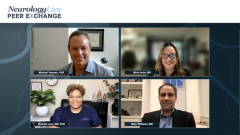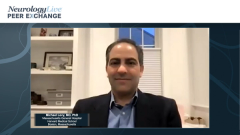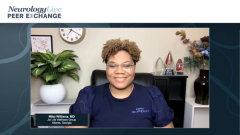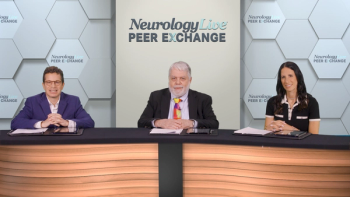
Raising NMOSD Awareness Through Continued Education
Mirla Avila, MD, leads a discussion on the impact of NMOSD on women’s health and the role of continued education for physicians.
Episodes in this series

Michael Yeaman, PhD: Mirla, we know that race and ethnicity can be factors that weigh into outcomes, but unfortunately, NMOSD [neuromyelitis optica spectrum disorder] is a condition that often impacts women at the time of life when children, families, and their careers need them most. I want to get your thoughts about the women’s health perspective as it relates to different population groups in your practice. Do you see any patterns or ways that we could improve?
Mirla Avila, MD: What I have seen is that most of my patients feel that I become their primary care [physician] and everything else. If they have NMOSD, they may not feel that they need to do everything else that they have to do, such as their pap smear or colonoscopies. I try to educate them that the fact that they have NMOSD doesn’t take away the importance of screening for other diseases, having a primary care physician for other purposes, and building a system of physicians who can work together if they’re having pain or they need to see a urologist.
Having a network of physicians who can all communicate well and serve the patient is sometimes lacking, especially with my Hispanic patients. There’s also some mistrust, not that much because of the medical community, but because they don’t want to give a lot of personal information because if they aren’t in this country legally, they’re afraid that can be used to their disadvantage. I’ve had many patients not wanting to give their phone numbers to be contacted because they’re afraid of that.
Michael Yeaman, PhD: Really important issues. This relates back to awareness and education and making sure as many health care providers as possible are aware of diagnosis and management but also the ways of communicating with and treating patients. That brings us to how we can improve. If educating health care providers is such an important goal, particularly in NMOSD, what’s the role of continued education, maybe CME [continuing medical education], conferences, or special smaller group meetings? How can we best educate emergency department [ED] physicians, GI [gastrointestinal] doctors, ophthalmologists, optometrists, and even family practice doctors, who are among the more common individuals to see patients first? Mitzi, let’s start with you and your thoughts.
Mitzi Williams, MD: Absolutely. CME is extremely important. I have been fortunate to participate in multiple conferences for family practice physicians. At one of my prior institutions, we had a nice conference called Neurology for the Non-Neurologist. It’s important for us to include these atypical presentations and case studies. I’ll often see a case study from a medical CME platform. How can we incorporate those types of presentations so that people are aware and not just saying it automatically has to be a GI problem if it’s nausea and vomiting, or this or that?
The other place to raise awareness is individually. Small group meetings are extremely effective and important, especially now that we have treatment options available for NMOSD. Having experts talk to other community neurologists and community physicians, whether that’s via tele-platforms or in-person meetings, is definitely going to be important for raising awareness, so they at least think of NMOSD when they see some of these presentations, and when they think about potentially MS [multiple sclerosis], they also put NMOSD in that differential.
Michael Yeaman, PhD: Exactly, Mitzi. Mirla, before you were an NMOSD specialist, what got you interested in NMOSD? How did you become a specialist? That can offer insights into the ways we might focus on to get people more interested and aware.
Mirla Avila, MD: Because I always loved immunology and neurology, neuroimmunology was the perfect field for me. I’m an associate program director. Most of the residents who graduate from our institution aren’t interested in neuroimmunology. You have to have a passion, like all of you have for neuroimmunology. Part of how we can make a difference is educating our residents and students so that even if they aren’t going to be in the field of neuroimmunology, they have an understanding of how to diagnose and maybe refer the patient if they aren’t comfortable treating the patient. That’s a way we can make a difference, by educating these residents and students who rotate with us.
Michael Yeaman, PhD: Thanks a lot, Mirla. Very important points. Michael, what would you rate as the best ways to educate, inform, and raise awareness among health care providers?
Michael Levy, MD, PhD: I’ve adopted a strategy of giving my contact information to my patients and saying, “When you see your ED doctor, primary physician, urologist, or whoever, tell them to give me a call. In 5 minutes, I can explain everything they need to know, and then they can give you the best care that they can give.” The ED doctor won’t be thinking you’re faking. The ophthalmologist will understand why your eye looks fine, but maybe your optic nerve is the problem. The urologist will understand that the problem isn’t the bladder but comes from the spinal cord. By text message, email, or telephone—however I can facilitate communication—I’ve found it saves me a lot more time and it saves the patients a lot of frustration to do it this way.
Michael Yeaman, PhD: It’s the “rising tide raises all ships” approach where everyone is informed and connected.
Transcript edited for clarity
Newsletter
Keep your finger on the pulse of neurology—subscribe to NeurologyLive for expert interviews, new data, and breakthrough treatment updates.































